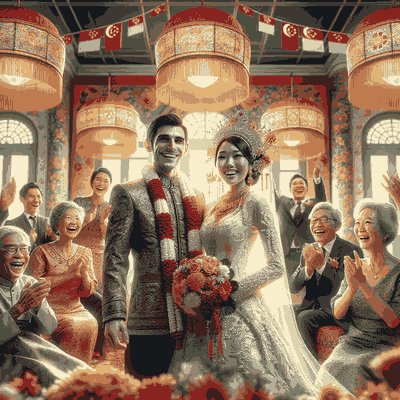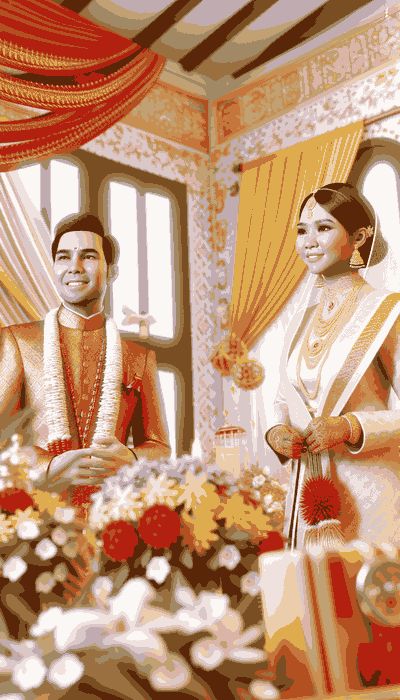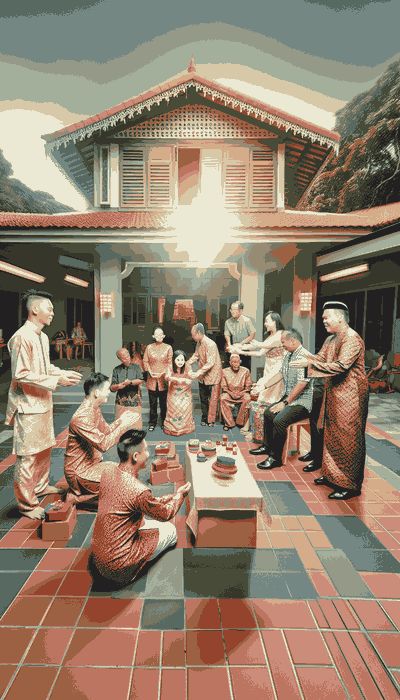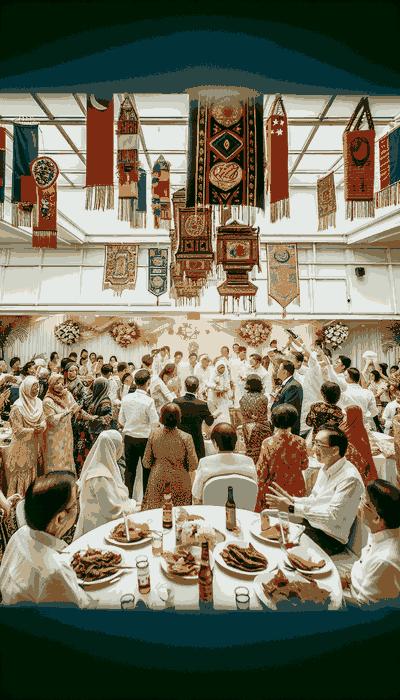Singaporean Wedding Traditions
Singapore wedding traditions are elaborate multi-cultural celebrations that blend Chinese, Malay, Indian, and Peranakan customs, typically lasting 1-7 days and involving 150-1000 guests from diverse ethnic communities. These celebrations encompass religious ceremonies like akad nikahah-KAHD nee-KAH and saptapadisahp-TAH-pah-dee, cultural rituals including guo da ligwoh-dah-lee and bersandingber-SAHN-ding, and modern fusion elements, with costs ranging from S$20,000-S$200,000 ($14,800-$148,000 USD) depending on scale and community.

Timeline Overview of Singapore Wedding Celebrations

- 6 months before: Astrological date selection, venue booking
- 3 months before: Guo da ligwoh-dah-lee (Chinese betrothal), invitation distribution
- 1 month before: Mehendimeh-HEN-dee night, bachelor/bachelorette parties
- 1 week before: Mandi bungaMAHN-dee BOON-gah (flower bath), religious preparations
- Wedding day: Morning ceremonies, evening banquet
- 3 days after: San zhao hui mensahn-jow-hway-men (return visit)
- 1 month after: Kenduri kesyukuranken-DOO-ree keh-syoo-KOO-rahn (thanksgiving feast)
Pre-Wedding Traditions: Guo Da Li, Khastgari, and Engagement Ceremonies

The Chinese Guo Da Li Ceremony
Guo da ligwoh-dah-lee is a Chinese betrothal ceremony that formalizes the engagement through elaborate gift exchanges between families, typically occurring 3-6 months before the wedding and involving 10-20 immediate family members at a cost of S$2,000-S$10,000 ($1,480-$7,400 USD). The groom’s family presents even-numbered gifts including roast pig, wedding cakes, and red packets to symbolize sincerity and abundance.
The ceremony follows a structured process where the groom’s party arrives before noon carrying pin jinpin-jin (betrothal money) of S$1,888-S$8,888, accompanied by traditional items like dragon and phoenix candles. Modern couples often substitute traditional roast pig with premium ham gifts, while maintaining the essential si dian jinsee-dee-ahn-jin (four pieces of gold jewelry) valued at S$3,000-S$15,000.
Regional variations within Singapore’s Chinese community see Hokkien families emphasizing lao bing (traditional pastries), Teochew families requiring specific tang baotahng-bao (sugar packets), and Cantonese families including guo da li wine. These variations traditionally followed by dialect group settlements in areas like Chinatown (Cantonese), Telok Ayer (Hokkien), and Geylang (Teochew).
Malay Engagement and Merisik Traditions
Merisikmeh-REE-sik is a Malay investigative tradition that precedes formal engagement, where the groom’s representatives discreetly visit the bride’s family to gauge interest, typically involving 5-8 elderly relatives and lasting 2-3 hours. This tradition remains largely unchanged in modern practice, though contemporary families often skip directly to meminangmeh-MEE-nahng (formal proposal).
The formal pertunanganper-too-NAHNG-ahn (engagement ceremony) occurs 6-12 months before the wedding, involving 50-100 guests and costing S$3,000-S$8,000 ($2,220-$5,920 USD). Families exchange hantaranhahn-TAH-rahn (gift trays) containing 7-9 items, with the groom’s side always presenting odd numbers and receiving even numbers in return.
Modern adaptations include professional hantaran decorators charging S$50-S$200 per tray, Instagram-worthy presentations, and practical gifts like electronics replacing traditional cloth and perfumes. The cincin belah rotanCHIN-chin beh-LAH roh-TAHN (split rattan ring) symbolizing engagement has evolved to include diamond solitaires worth S$2,000-S$20,000.
Indian Pre-Wedding Rituals and Roka Ceremonies
Rokaroh-KAH is a North Indian pre-wedding blessing ceremony that publicly announces the couple’s intention to marry, typically held 6-8 months before the wedding with 30-50 close relatives and costing S$2,000-S$5,000 ($1,480-$3,700 USD). South Indian communities practice nichayatharthamnee-CHAI-yah-TAR-tahm with similar purposes but different rituals.
The ceremony involves tilakTEE-lahk application on the groom’s forehead using kumkum and rice, followed by shagunshah-GOON (token money) exchanges of S$101-S$1,001. Modern Singaporean Indian families often combine roka with sagaisah-GAH-ee (ring ceremony) to minimize gatherings, particularly in HDB venues where space constraints limit guest numbers.
Kundalikoon-DAH-lee matching (astrological compatibility) precedes all engagement discussions, with professional astrologers charging S$200-S$800 for detailed analysis. Contemporary couples increasingly use online matching services, though 75% of families still insist on traditional pandits for final verification.
Wedding Day Ceremonies: Akad Nikah, Tea Ceremony, and Saptapadi

The Malay Akad Nikah
Akad nikahah-KAHD nee-KAH is an Islamic marriage solemnization ceremony that legally binds the couple through the recitation of marriage vows in the presence of a kadi and witnesses, typically lasting 30-45 minutes with 50-200 guests at mosque venues costing S$300-S$1,000 ($220-$740 USD). The ceremony requires the presence of the waliWAH-lee (bride’s guardian), two male witnesses, and mas kahwinmahs KAH-win (dower) of S$100-S$500.
The solemnization follows strict protocols where the groom must recite the ijab qabulee-JAHB kah-BOOL (offer and acceptance) in one breath, clearly stating the bride’s name, mas kahwin amount, and acceptance. Modern variations include bilingual ceremonies for intercultural couples and female witnesses in progressive interpretations.
Bersandingber-SAHN-ding is the celebratory sitting-in-state ceremony that follows akad nikah, where the couple receives blessings from guests while seated on an elaborately decorated pelaminpeh-LAH-min (bridal dais), typically lasting 3-4 hours with 200-800 guests. The ceremony costs S$5,000-S$30,000 ($3,700-$22,200 USD) including venue, catering, and bunga telurBOON-gah teh-LOOR (egg flowers) given to guests.
The Chinese Tea Ceremony
Cha lichah-lee is a Chinese tea ceremony that shows respect to elders and formally introduces the bride to the groom’s family, typically conducted in the morning before the wedding banquet and involving 20-50 relatives over 1-2 hours. The ceremony requires specific gaiwanguy-wahn tea sets, premium tea leaves, and red cushions, costing S$500-S$2,000 ($370-$1,480 USD) for materials.
The serving order follows strict hierarchy: paternal grandparents first, then parents, followed by uncles and aunts in age order. Each elder presents hong baohong-bao (red packets) containing S$88-S$8,888 or gold jewelry after drinking the tea, with the couple addressing them by their new familial titles.
Modern adaptations include condensed ceremonies serving only immediate family, video recordings for overseas relatives, and casual dress codes replacing full traditional attire. However, 85% of Singaporean Chinese families maintain the essential elements of kneeling, serving with both hands, and receiving blessings.
The Indian Saptapadi
Saptapadisahp-TAH-pah-dee is a Hindu wedding ritual where the couple takes seven sacred steps around the holy fire while making seven promises, typically occurring during a 2-3 hour ceremony with 200-500 guests at temple venues costing S$5,000-S$20,000 ($3,700-$14,800 USD). Each step represents a specific vow: nourishment, strength, prosperity, happiness, progeny, seasons, and friendship.
The ritual requires agniAHG-nee (sacred fire) maintained by the priest using specific woods and ghee, with the couple’s garments tied together by granthi bandhanamGRAHN-thee bahn-DAH-nahm. North Indian variations include pherasFEH-rahs (circling the fire), while South Indian traditions emphasize mangalsutramahn-gahl-SOO-trah tying and sindoorsin-DOOR application.
Tamil variations include oonjalOON-jahl (swing ceremony) where the couple sits on a decorated swing while being fed milk and bananas by married women. The kanyadaankahn-yah-DAHN (giving away of bride) precedes saptapadi, with the bride’s father placing her hand in the groom’s while reciting Sanskrit mantras.
Post-Wedding Celebrations: San Zhao Hui Men and Kenduri
Chinese Three-Day Return (San Zhao Hui Men)
San zhao hui mensahn-jow-hway-men is a Chinese post-wedding tradition where newlyweds visit the bride’s family on the third day after marriage, bringing specific gifts and performing tea ceremonies, typically lasting 4-6 hours with 20-50 family members and costing S$1,000-S$5,000 ($740-$3,700 USD). The tradition symbolizes the bride’s continued connection to her birth family despite joining her husband’s household.
Traditional gifts include whole roasted pig (or premium ham), wine, oranges in even numbers, and fa gaofah-gow (prosperity cakes). The bride’s family reciprocates with household items for the new home, including bedding, kitchenware, and symbolic fertility items like pomegranates.
Modern couples often schedule the return visit on weekends for convenience, replacing whole roasted pig with luxury hampers worth S$500-S$2,000. Restaurant venues increasingly host these gatherings, with set menus ranging S$688-S$1,888 for tables of ten.
Malay Kenduri Traditions
Kenduri kesyukuranken-DOO-ree keh-syoo-KOO-rahn is a Malay community thanksgiving feast held 1-4 weeks after the wedding to share blessings with the neighborhood, typically involving 200-1000 guests at void deck venues costing S$5,000-S$20,000 ($3,700-$14,800 USD). The event emphasizes gotong royonggoh-TONG roh-YONG (community cooperation) with neighbors contributing labor and resources.
The preparation begins days in advance with rewangreh-WAHNG (volunteer cooking), where community members prepare traditional dishes like rendangren-DAHNG, nasi minyakNAH-see MIN-yahk, and ayam masak merahAH-yahm MAH-sahk MEH-rah. Modern catering services offer kenduri packages at S$8-S$15 per person, though many families maintain home cooking for authenticity.
Berkatber-KAHT distribution (blessed food packages) concludes the kenduri, with guests receiving containers of food to take home. Contemporary berkat includes practical items like prayer mats or household goods alongside traditional pulut kuningpoo-LOOT koo-NING (yellow glutinous rice) and eggs.
Modern Fusion Wedding Trends in Singapore
Intercultural Ceremony Adaptations
Intercultural weddings in Singapore blend multiple ethnic traditions into cohesive celebrations, with 35% of marriages crossing ethnic boundaries and requiring creative ceremonial adaptations costing S$50,000-S$150,000 ($37,000-$111,000 USD). These weddings typically feature sequential ceremonies honoring both cultures, unified color schemes, and carefully planned menus accommodating various dietary restrictions.
Chinese-Malay unions often conduct akad nikahah-KAHD nee-KAH in the morning followed by tea ceremony, with halal Chinese banquets featuring dishes like halal roast duck and longevity noodles. Indian-Chinese couples might combine saptapadisahp-TAH-pah-dee with tea ceremony, using red and gold themes throughout both events.
Venue selection for fusion weddings prioritizes neutral spaces like hotels and country clubs that accommodate multiple ceremonial requirements. The Fullerton Hotel, Capella Singapore, and Shangri-La charge S$1,500-S$3,000 per table with flexibility for various ritual setups.
Cost Comparisons: Traditional vs Modern
| Aspect | Traditional | Modern | Fusion |
|---|---|---|---|
| Duration | 3-7 days | 1-2 days | 2-3 days |
| Guest Count | 500-1000 | 150-300 | 200-400 |
| Venue Cost | S$10,000-S$30,000 | S$30,000-S$80,000 | S$40,000-S$100,000 |
| Ceremony Count | 5-8 rituals | 2-3 rituals | 3-4 rituals |
| Total Budget | S$40,000-S$80,000 | S$60,000-S$150,000 | S$80,000-S$200,000 |
Regional Variations Within Singapore
East Coast Chinese Traditions
East Coast Chinese weddings concentrate in Marine Parade and Katong areas where Peranakan influences blend with mainstream Chinese customs, featuring unique elements like cheo thauchee-oh-tao (head combing ceremony) performed by sang kheh umsahng-keh-oom (wedding mistress), typically involving 200-400 guests at heritage venues costing S$70,000-S$150,000 ($51,800-$111,000 USD).
The region’s Peranakan heritage adds distinctive elements including nyonya kuehNYOH-nyah kway displays, kebayakeh-BAH-yah wedding attire, and dondang sayangdon-DAHNG sah-YAHNG performances. Modern couples incorporate these elements selectively, with professional bibiks charging S$500-S$1,500 to conduct traditional ceremonies.
Kampong Glam Malay Customs
Kampong Glam weddings preserve traditional Malay customs within the historic Muslim quarter, where 85% of ceremonies incorporate kompangkom-PAHNG drum ensembles, silatsee-LAHT performances, and mosque solemnizations at Sultan Mosque or Hajjah Fatimah Mosque. These celebrations typically host 400-800 guests with budgets of S$40,000-S$80,000 ($29,600-$59,200 USD).
The area’s Bugis and Arab influences introduce unique elements like zapinzah-PEEN dances and Middle Eastern cuisine alongside traditional Malay fare. Modern adaptations include rooftop venues overlooking the mosque and Instagram-worthy locations in Haji Lane for pre-wedding shoots.
Little India Tamil Celebrations
Little India Tamil weddings center around Sri Veeramakaliamman Temple and Sri Srinivasa Perumal Temple, featuring elaborate nadaswaramnah-dah-SWAH-rahm music, kolamkoh-LAHM competitions, and traditional vegetarian feasts for 500-1000 guests costing S$50,000-S$120,000 ($37,000-$88,800 USD). The neighborhood’s wedding infrastructure includes specialized vendors for muhurthammoo-HOOR-tahm saris, jadaijah-DIE (hair decoration), and temple flower arrangements.
Contemporary celebrations often book entire restaurants along Serangoon Road, with some venues offering live cooking stations for dosas and filter coffee. The tradition of sumangali prarthanaisoo-mahn-GAH-lee prahr-TAH-nai (married women’s blessings) continues with modern touches like coordinated sari colors and professional photography.
How much does a typical Singapore wedding cost across different ethnicities?
Singapore wedding costs vary significantly by ethnicity and scale, with Chinese weddings averaging S$60,000-S$100,000 ($44,400-$74,000 USD) for hotel banquets of 300-500 guests, Malay weddings costing S$40,000-S$80,000 ($29,600-$59,200 USD) for void deck celebrations with 400-800 attendees, and Indian weddings ranging S$50,000-S$120,000 ($37,000-$88,800 USD) for temple ceremonies with 500-1000 guests. Modern fusion weddings combining multiple traditions typically exceed S$80,000-S$200,000 ($59,200-$148,000 USD) due to multiple ceremonies, neutral venues, and specialized catering requirements. The main cost factors include venue selection (30-40% of budget), catering (25-35%), and ceremonial elements like guo da ligwoh-dah-lee gifts, mas kahwinmahs KAH-win, or kanyadaankahn-yah-DAHN requirements (15-25%).
What is the typical duration of wedding celebrations in Singapore?
Traditional Singapore weddings span multiple days depending on ethnicity, with Chinese celebrations lasting 1-3 days including guo da li and san zhao hui mensahn-jow-hway-men, Malay weddings extending 3-5 days from akad nikahah-KAHD nee-KAH through kenduri, and Indian weddings running 3-7 days covering mehendimeh-HEN-dee, saptapadisahp-TAH-pah-dee, and grihapraveshamgree-hah-prah-VEH-shahm. Modern urban couples increasingly compress celebrations into 1-2 days, combining ceremonies like morning solemnization with evening banquets. The trend toward shorter durations reflects practical constraints including venue availability, guest schedules, and costs, with 70% of couples under 35 opting for condensed celebrations while maintaining essential cultural elements.
Who typically attends the various wedding ceremonies?
Singapore wedding guest lists vary by ceremony type and ethnicity, with intimate rituals like guo da li involving 10-20 immediate family members, religious ceremonies like akad nikah hosting 50-200 close relatives and friends, and grand receptions accommodating 300-1000 guests from extended networks. Chinese tea ceremonies traditionally include only family members within three generations, while Malay kenduri events welcome entire neighborhoods through gotong royonggoh-TONG roh-YONG participation. Indian celebrations differentiate between sacred ceremonies for family (100-200 people) and reception parties for broader communities (500-1000 guests), with modern couples often creating multiple guest tiers to manage costs and venue constraints.
How do Singapore’s regional differences affect wedding traditions?
Regional variations within Singapore create distinct wedding experiences, with East Coast Chinese weddings incorporating Peranakan elements like cheo thauchee-oh-tao ceremonies at heritage venues, Kampong Glam preserving authentic Malay customs with kompangkom-PAHNG performances at void decks, and Little India maintaining elaborate Tamil traditions with temple ceremonies and nadaswaramnah-dah-SWAH-rahm music. These geographic concentrations result from historical settlement patterns, with specific vendors, venues, and service providers clustering in ethnic enclaves. Modern couples leverage these regional specializations, traveling across Singapore to access authentic elements - hiring sang kheh umsahng-keh-oom from Katong, booking kompang groups from Geylang, or sourcing muhurthammoo-HOOR-tahm saris from Serangoon.
What are the main differences between traditional kampong and modern urban weddings?
Kampong-style weddings emphasize community participation through gotong royong cooking, open invitations to entire neighborhoods, and multi-day celebrations at void decks costing S$20,000-S$50,000 ($14,800-$37,000 USD), while urban hotel weddings feature professional catering, guest lists limited by table purchases, and single-day events costing S$50,000-S$150,000 ($37,000-$111,000 USD). Traditional elements like masak bersamaMAH-sahk ber-SAH-mah (communal cooking) and jemput semuajem-POOT seh-MOO-ah (open house) give way to scheduled receptions and RSVP systems. However, modern couples increasingly seek hybrid approaches, incorporating kampong aesthetics through rooftop garden venues, live cooking stations mimicking communal preparation, and extended cocktail hours allowing flexible attendance.
How long do Malay kenduri celebrations typically last?
Kenduri kesyukuranken-DOO-ree keh-syoo-KOO-rahn traditionally spans 2-3 days of preparation followed by a 4-6 hour main event, though modern celebrations often compress into single-day affairs lasting 3-4 hours to accommodate urban schedules and venue bookings. The traditional timeline includes rewangreh-WAHNG (communal cooking) starting two days prior, kenduri setup from dawn, guest reception from 11am-3pm, and berkatber-KAHT distribution concluding by evening prayers. Contemporary adaptations feature professional catering reducing preparation to hours, streamlined serving replacing dulangdoo-LAHNG (communal platters) with buffet lines, and pre-packed berkat enabling faster distribution, allowing families to maintain cultural significance within practical constraints.
What are the essential elements of a Chinese tea ceremony?
The Chinese cha lichah-lee (tea ceremony) requires specific elements including premium tea leaves (typically tieguanyintee-eh-gwahn-yin or pu’er), traditional gaiwanguy-wahn tea sets with matching cups, red cushions for kneeling, and gold jewelry or hong baohong-bao for elder gifts, with setups costing S$500-S$2,000 ($370-$1,480 USD). The ceremony follows strict protocols: serving order by seniority, kneeling while offering tea with both hands, addressing elders by new familial titles, and receiving blessings after tea consumption. Modern essentials maintain the core while adapting logistics - using chairs for elderly relatives, condensing participant lists to immediate family, and incorporating video calls for overseas relatives, ensuring the ritual’s essence of respect and family unity remains intact.
How do intercultural couples handle different religious requirements?
Intercultural couples in Singapore navigate religious differences through sequential ceremonies (conducting akad nikah then saptapadi), unified venues accommodating multiple faiths, and careful timing to respect both traditions, with 40% opting for civil solemnization followed by cultural celebrations. Common solutions include morning religious ceremonies for devout family members followed by evening secular receptions, neutral menu planning with halal, vegetarian, and regular options, and professional celebrants familiar with fusion requirements. Legal considerations require ROMs registration regardless of religious ceremonies, with couples often conducting multiple solemnizations to satisfy various family expectations while maintaining personal preferences.
What are typical mas kahwin amounts in Singapore?
Mas kahwin (dower) in Malay weddings typically ranges from S$100-S$500 ($74-$370 USD) as symbolic amounts fulfilling Islamic requirements, distinct from hantaranhahn-TAH-rahn gifts worth S$5,000-S$20,000 ($3,700-$14,800 USD) representing family agreements. The religious minimum remains unchanged at S$100, while social expectations drive hantaran inflation, with educated professionals expecting S$10,000-S$30,000 packages including jewelry, electronics, and cash. Modern negotiations balance religious obligations with practical considerations, with some couples publicizing minimal mas kahwin while privately arranging substantial hantaran, maintaining face while managing financial pressures.
How have Singapore wedding traditions adapted post-pandemic?
Post-pandemic adaptations in Singapore weddings include hybrid ceremonies with livestreaming for overseas guests, smaller guest lists of 50-150 people replacing 500-person banquets, and flexible vendor contracts accommodating restrictions, with technology integration becoming permanent features worth S$2,000-S$10,000 ($1,480-$7,400 USD). Safe distancing measures evolved into preferred practices like cocktail-style receptions replacing dulang sharing, QR code invitations and digital ang baoahng-bao replacing physical exchanges, and outdoor venues gaining popularity over ballrooms. These changes reduced average wedding costs by 20-30% while increasing per-guest spending on premium experiences, with couples investing in quality over quantity.
Frequently Asked Questions
How much does a traditional Singapore wedding typically cost?
Singapore weddings typically cost between S$20,000 to S$200,000, depending on the scale, traditions observed, and venue choice.
What is Guo Da Li and when does it happen?
Guo Da Li is a Chinese betrothal ceremony occurring 3-6 months before the wedding, where the groom's family presents traditional gifts to the bride's family.
How long do Singapore weddings usually last?
Singapore weddings can last between 1-7 days, depending on the cultural traditions being observed.
What happens during a Chinese tea ceremony?
The tea ceremony is a morning ritual where the couple serves tea to family members in order of seniority, receiving red packets and blessings in return.
What is the Malay Akad Nikah ceremony?
Akad Nikah is the Islamic solemnization ceremony, followed by the Bersanding sitting-in-state ritual where couples are presented as newlyweds.
How many guests typically attend a Singapore wedding?
Singapore weddings usually host between 150-1000 guests, depending on family size and cultural traditions.
What is Saptapadi in Indian weddings?
Saptapadi is a Hindu ritual where the couple takes seven sacred vows while walking around a holy fire.
How are modern couples adapting traditional customs?
Modern couples often blend different cultural traditions, use neutral venues, and incorporate specialized catering to honor multiple heritages.
What is the significance of San Zhao Hui Men?
San Zhao Hui Men is a Chinese post-wedding tradition where newlyweds visit the bride's family on the third day, bringing gifts.
What happens during a Malay Kenduri?
Kenduri is a community thanksgiving feast held 1-4 weeks after the wedding, featuring volunteer cooking and distribution of berkat (food gifts).